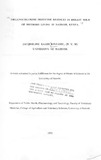| dc.description.abstract | A total of 216 human milk samples were collected from mothers either attending
post natal clinics or in the maternity wards of some hospitals in Nairobi. The
samples were analysed for organochlorine pesticides by use of a gas liquid
chromatograph equipped with a 63Ni electron capture detector. Thirteen
organochlorine pesticides were detected in the following order of frequency:- p,p'-
DDE (99.5%), p,p'-DDT (78.2%), dieldrin (37.5%), I)-HeH (16.2%), lindane
(16.2%), o,p'-DDT (11.5%), a-HeH (11.1 %), heptachlor (10.2%), p,p'-DDD
(9.3%), aldrin (5.6%), heptachlor epoxide (4.2%), endrin (2.7%), and o,p'-DDD
(0.44%).
The mean level (mg/kg milk fat) of sum DDT in all the human milk samples
analysed was 0.47 and ranged from 0.004 to 6.32. Mean levels (mg/kg milk fat) of
the other residues identified were as follows:- dieldrin 0.022, I)-HeH 0.089,
lindane 0.017, a-HeH 0.067, heptachlor 0.026, aldrin 0.03, heptachlor epoxide
0.017, and endrin 0.035 ..
There were significant differences (p<0.05) in the levels of sum-DDT and p,p'-
DDE, in relation to the parity of the mother with higher levels being observed in
mothers nursing their first child as compared to those nursing their second child.
Mean level (mg/kg milk fat) of sum-DDT was 0.51 in primipara and 0.41 in
secundipara while mean level (mg/kg milk fat) of p,p'-DDE was 0.32 in primipara
and 0.28 in secundipara.The other factors found to affect the levels of
organochlorine pesticides in this study were, maternal age and fat content of the
milk. Diet, social class and race of the mother were not significant contributors
(p>0.05) to the pesticide levels in the human milk. The mean ratio of p,p'-DDT to
p,p'-DDE was low implying less exposure of the population to the parent
compound p,p'-DDT.
The levels of the organochlorine pesticides in this study were lower than levels
observed in an earlier study carried out in the rural areas of Kenya and also in some
cases
lower than levels observed in earlier studies carried out in some industrialised
countries.
The estimated daily intake of sum-DDT, dieldrin, aldrin and endrin by the infant
was found to exceed the acceptable daily intake (ADI) set by the World Health
Organisation.
Food samples collected from major markets in Nairobi were examined for
organochlorine residues. Contamination of the food samples with organochlorine
pesticides was low and only residues of dieldrin, p,p'-DDE, p,p'-DDT were
detected. Food of animal origin was found to contain higher levels of
organochlorines than food of plant origin. Although the contamination of food with
organochlorine pesticides was low the presence of DDT, DDE and dieldrin in some
food stuffs demonstrated that food could be one of the sources of these compounds
in the human milk. | en |

